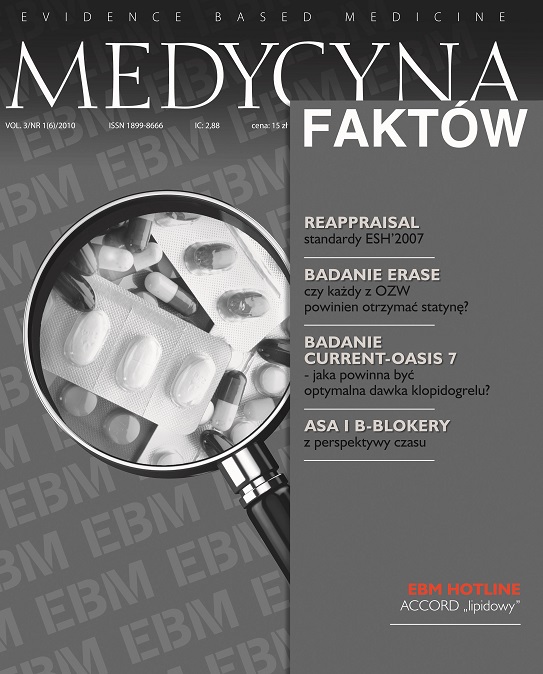Badanie ACCORD potwierdza dotychczasowe wskazania do leczenia fibratami w cukrzycy typu 2 – komentarz do wyników badania ACCORD Commentary
Main Article Content
Abstract
None
Article Details
How to Cite
Pikto-Pietkiewicz , W. (2010). Badanie ACCORD potwierdza dotychczasowe wskazania do leczenia fibratami w cukrzycy typu 2 – komentarz do wyników badania ACCORD. Medycyna Faktow (J EBM), 3(1(6), 137-141. Retrieved from https://journalsmededu.pl/index.php/jebm/article/view/2625
Issue
Section
Articles
Copyright © by Medical Education. All rights reserved.
References
1. ATP III. Executive Summary of The Third Report of The National Cholesterol Education Program (NCEP) Expert Panel on Detection, Evaluation, And Treatment of High Blood Cholesterol In Adults (Adult Treatment Panel III). [PMID: 11368702] JAMA 2001; 285: 2486-97.
2. UK Prospective Diabetes Study (UKPDS) Group. Intensive blood-glucose control with sulphonylureas or insulin compared with conventional treatment and risk of complications in patients with type 2 diabetes (UKPDS 33). [PMID: 9742976] Lancet 1998; 352: 837-53.
3. Pikto-Pietkiewicz W., Wołkowska K., Pasierski T.: Treatment of dyslipidemia in patients with diabetes mellitus. Pharmacological Reports 2005; 57 (suppl.): 10-19.
4. Pikto-Pietkiewicz W, Pasierski T. Zaburzenia lipidowe w chorobach nerek. w: Kardionefrologia. Red. PasierskiT, Myśliwiec M., Imiela J. Medicla Tribune Polska. Warszawa 2006: 87-100.
5. Diabetes Atherosclerosis Intervention Study Investigators: Effect of fenofibrate on progression of coronary artery disease in type 2 diabetes: Diabetes Atherosclerosis Intervention Study, a randomized study. Lancet 2001; 357: 905.
6. Keech A., Simes R.J., Barter P. et al.: Effects of long-term fenofibrate therapy on cardiovascular events in 9795 people with type 2 diabetes mellitus (the FIELD study): randomised controlled trial. Lancet 2005; 366: 1849-6.
7. The ACCORD Study Group. Effects of Combination Lipid Therapy in Type 2 Diabetes Mellitus. 10.1056/nejmoa1001282 nejm.org.
8. Manninen V., Elo O., Frick H. et al.: Lipid alteration and decline in the incidence of coronary heart disease in the Helsinki Heart Study. JAMA 1988; 260: 641-651.
9. The BIP Study Group: Secondary prevention by rising HDL cholesterol and reducing triglicerides in patients with coronary artery disease. The Bezafibrate Infarction Prevention (BIP) study. Circulation 2000; 102: 21.
2. UK Prospective Diabetes Study (UKPDS) Group. Intensive blood-glucose control with sulphonylureas or insulin compared with conventional treatment and risk of complications in patients with type 2 diabetes (UKPDS 33). [PMID: 9742976] Lancet 1998; 352: 837-53.
3. Pikto-Pietkiewicz W., Wołkowska K., Pasierski T.: Treatment of dyslipidemia in patients with diabetes mellitus. Pharmacological Reports 2005; 57 (suppl.): 10-19.
4. Pikto-Pietkiewicz W, Pasierski T. Zaburzenia lipidowe w chorobach nerek. w: Kardionefrologia. Red. PasierskiT, Myśliwiec M., Imiela J. Medicla Tribune Polska. Warszawa 2006: 87-100.
5. Diabetes Atherosclerosis Intervention Study Investigators: Effect of fenofibrate on progression of coronary artery disease in type 2 diabetes: Diabetes Atherosclerosis Intervention Study, a randomized study. Lancet 2001; 357: 905.
6. Keech A., Simes R.J., Barter P. et al.: Effects of long-term fenofibrate therapy on cardiovascular events in 9795 people with type 2 diabetes mellitus (the FIELD study): randomised controlled trial. Lancet 2005; 366: 1849-6.
7. The ACCORD Study Group. Effects of Combination Lipid Therapy in Type 2 Diabetes Mellitus. 10.1056/nejmoa1001282 nejm.org.
8. Manninen V., Elo O., Frick H. et al.: Lipid alteration and decline in the incidence of coronary heart disease in the Helsinki Heart Study. JAMA 1988; 260: 641-651.
9. The BIP Study Group: Secondary prevention by rising HDL cholesterol and reducing triglicerides in patients with coronary artery disease. The Bezafibrate Infarction Prevention (BIP) study. Circulation 2000; 102: 21.

